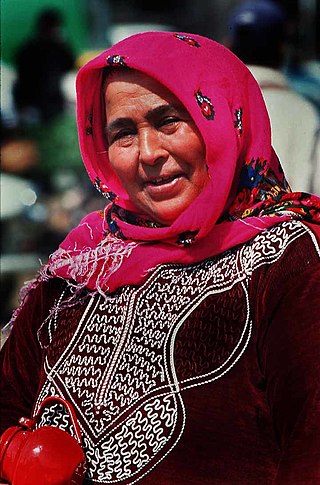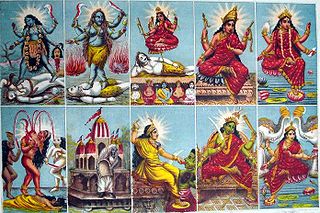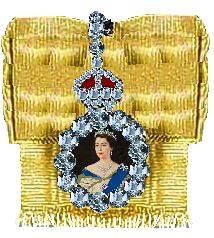Related Research Articles

In modern usage, hijab generally refers to variety of head coverings conventionally worn by many religious Muslim women as an expression of faith. Such women may be called "hijabi". Similar to the mitpaḥat/tichel or snood worn by religious married Jewish women, certain headcoverings worn by some Christian women, such as the hanging veil, apostolnik and kapp, and the dupatta favored by many Hindu and Sikh women, the hijab comes in various forms. Often, it specifically describes a scarf that is wrapped around the head, covering the hair, neck, and ears while leaving the face visible. The use of the hijab has grown globally since the 1970s, with many Muslims viewing it as a symbol of modesty and faith; it is also worn as a form of adornment. There is consensus among Islamic religious scholars that covering the head is either required or preferred. In practice, most Muslim women choose to wear it.

The Mahavidya are a group of ten Hindu Tantric goddesses. The 10 Mahavidyas are usually named in the following sequence: Kali, Tara, Tripura Sundari, Bhuvaneshvari, Bhairavi, Chhinnamasta, Dhumavati, Bagalamukhi, Matangi and Kamalatmika. Nevertheless, the formation of this group encompass divergent and varied religious traditions that include yogini worship, Saivism, Vaishnavism, and Vajrayana Buddhism.

The handkerchief code is a system of color-coded cloth handkerchief or bandanas for non-verbally communicating one's interests in sexual activities and fetishes. The color of the handkerchief identifies a particular activity, and the pocket it is worn in identifies the wearer's preferred role in that activity. Wearing a handkerchief on the left side of the body typically indicates one is a "top" while wearing it on the right side of the body would indicate one is a "bottom". For example, a dark blue handkerchief indicates an interest in anal sex, and wearing it in the left pocket indicates a preference for being the penetrating partner. The code was first used in the 1970s in the United States, Canada, Australia, and Europe, by gay and bisexual men seeking casual sex or BDSM practitioners. Over time the colors and types of apparel in use have greatly proliferated.

A turban is a type of headwear based on cloth winding. Featuring many variations, it is worn as customary headwear by people of various cultures. Communities with prominent turban-wearing traditions can be found in the Indian subcontinent, Southeast Asia, the Middle East, the Balkans, the Caucasus, Central Asia, North Africa, West Africa, East Africa, and amongst some Turkic peoples in Russia.

The Phrygian cap, also known as Thracian cap and liberty cap, is a soft conical cap with the apex bent over, associated in antiquity with several peoples in Eastern Europe, Anatolia and Asia. The Phrygian cap was worn by Thracians, Dacians, Persians, Medes, Scythians, Trojans, Amazons and Phrygians after whom it's named. The oldest known depiction of the Phrygian cap is from Persepolis in Iran.
The posterior probability is a type of conditional probability that results from updating the prior probability with information summarized by the likelihood via an application of Bayes' rule. From an epistemological perspective, the posterior probability contains everything there is to know about an uncertain proposition, given prior knowledge and a mathematical model describing the observations available at a particular time. After the arrival of new information, the current posterior probability may serve as the prior in another round of Bayesian updating.
A bolo tie is a type of necktie consisting of a piece of cord or braided leather with decorative metal tips and secured with an ornamental clasp or slide.

A scarf is a long piece of fabric that is worn on or around the neck, shoulders, or head. A scarf is used for warmth, sun protection, cleanliness, fashion, religious reasons, or to show support for a sports club or team. Scarves can be made from materials including wool, linen, silk, and cotton. It is a common type of neckwear and a perennial accessory.

Dame Mary Louise Webster,, known professionally as May Whitty and later, for her charity work, Dame May Whitty, was an English stage and film actress. She was one of the first two women entertainers to become a Dame. The British actors' union Equity was established in her home in 1930.

A durag is a close-fitting cloth tied around the top of the head to protect the hair; similarly a wave cap is a close-fitting cap for the same purpose. Durags may be worn to accelerate the development of long curly/kinky hair, waves or locks in the hair; to maintain natural oils in hair ; to stop hair breakage; to manage hair in general; or to keep hair, wave patterns and braids from shifting while sleeping. Durags are also worn as an identity-making fashion choice, popular in Black culture and African-American culture.

Morning dress, also known as formal day dress, is the formal Western dress code for day attire, consisting chiefly of a morning coat, waistcoat, and formal trousers for men, and an appropriate gown for women. Men may also wear a popular variant, where all parts are the same colour and material, often grey, and usually called "morning suit" or "morning grey" to distinguish it; considered properly appropriate only to festive functions, such as summer weddings and horse races, which consequently makes it slightly less formal. The correct hat would be a formal top hat, or if on less spacious audience settings, optionally a collapsible equivalent opera hat.

The Jewish hat, also known as the Jewish cap, Judenhut (German) or Latin pileus cornutus, was a cone-shaped pointed hat, often white or yellow, worn by Jews in Medieval Europe. Initially worn by choice, its wearing was enforced in some places in Europe after the 1215 Fourth Council of the Lateran for adult male Jews to wear while outside a ghetto to distinguish them from others. Like the Phrygian cap that it often resembles, the hat may have originated in pre-Islamic Persia, as a similar hat was worn by Babylonian Jews.

The pschent was the double crown worn by rulers in ancient Egypt. The ancient Egyptians generally referred to it as Pa-sekhemty (pꜣ-sḫm.ty), the Two Powerful Ones, from which the Greek term is derived. It combined the White Hedjet Crown of Upper Egypt and the Red Deshret Crown of Lower Egypt.

Nemes consisted of pieces of striped head cloth worn by pharaohs in ancient Egypt. It covered the whole crown and behind of the head and nape of the neck and had lappets, two large flaps which hung down behind the ears and in front of both shoulders. It was sometimes combined with the double crown, as it is on the statues of Ramesses II at Abu Simbel. The earliest depiction of the nemes, along with a uraeus, is the ivory label of Den from the 1st Dynasty. It is not a crown in itself, but still symbolizes the pharaoh's power.

Outside Western cultures, men's clothing commonly includes skirts and skirt-like garments; however, in the Americas and much of Europe, skirts are usually seen as feminine clothing and socially stigmatized for men and boys to wear, despite having done so for centuries. While there are exceptions, most notably the cassock and the kilt, these are not generally considered skirts in the typical sense of fashion wear; rather they are worn as cultural and vocational garments. People have variously attempted to promote the fashionable wearing of skirts by men in Western culture and to do away with this gender distinction.

The Royal Family Order of Elizabeth II is an honour which was bestowed on female members of the British royal family by Queen Elizabeth II. The order is worn by recipients on formal occasions.

Trousers, slacks, or pants are an item of clothing worn from the waist to anywhere between the knees and the ankles, covering both legs separately. In some parts of the United Kingdom, the word pants is ambiguous: it can mean underpants rather than trousers. Shorts are similar to trousers, but with legs that come down only to around the area of the knee, higher or lower depending on the style of the garment. To distinguish them from shorts, trousers may be called "long trousers" in certain contexts such as school uniform, where tailored shorts may be called "short trousers" in the UK.

Sbai or phaa biang is a shawl-like garment worn by women in Cambodia, Laos, and Thailand to cover the breasts, while in Sumatra, Borneo and the Malay Peninsula, the same term is used to describe a cloth hanging from the shoulders. The sbai was derived from the Indian sari, the end of which is worn over one shoulder.

Open drawers are undergarments where the backs and front of the legs are not joined together; they were split in the middle to make it easier to urinate. As chemises decreased in length, open drawers stopped being used. In the late 19th century, there was debate about women wearing open or closed drawers.

The modius is a type of flat-topped cylindrical headdress or crown found in ancient Egyptian art and art of the Greco-Roman world. The name was given by modern scholars based on its resemblance to the jar used as a Roman unit of dry measure, but it probably does represent a grain-measure, and symbolizing one's ability to learn new information by having an open mind with an empty cup. Serapis was the main idol/figurehead at the Library of Alexandria during the ancient Egyptian & Roman alliance.
References
- ↑ Wearing p.615